In the 5th century, the migration of warlike Germanic tribes across northern Europe culminated in the destruction of the Roman Empire in the west. That much is well known but the “why”, less so. What would a people so fearsome as to bring down an empire, have to flee from?
The Roman Empire was split in the 5th century and ruled by two separate governments. Ravenna, in northern Italy, became capital to the Western Empire in 402 and would remain so until the final collapse, in 476. 1,200 miles to the east Constantinople, destined to become modern day Istanbul, ruled the Byzantine Empire.

Vast populations moved westward from Germania during the early fifth century, and into Roman territories in the west and south. They were Alans and Vandals, Suebi, Goths, and Burgundians. There were others as well, crossing the Rhine and the Danube and entering Roman Gaul. They came not in conquest: that would come later.
These tribes were fleeing the Huns: a people so terrifying that whole tribes agreed to be disarmed, in exchange for the protection of Rome.
Rome itself had mostly friendly relations with the Hunnic Empire, which stretched from modern day Germany in the west, to Turkey and most of Ukraine in the east. The Huns were nomads, mounted warriors whose main weapons were the bow and javelin. Huns frequently acted as mercenary soldiers, paid to fight on behalf of Rome.
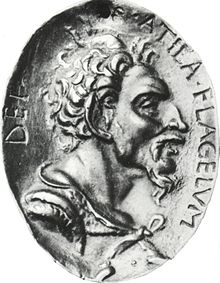
Rome looked at such payments as just compensation for services rendered. To the Huns this was tribute, tokens of Roman submission to the Hunnic Empire.
Nestorius, Patriarch of Constantinople, described the Roman-Hun problem, succinctly: “They have become both masters and slaves of the Romans”.
Relations were strained between the two powers in the time of the Hunnic King, Rugila.

Rugila’s death in 434 left the sons of his brother Mundzuk, Attila and Bleda, in control of the united Hunnic tribes. The brothers negotiated a treaty with Emperor Theodosius of Constantinople the following year, giving him time to strengthen the city’s defenses. This included building the first sea wall, the formidable Theodosian Wall.
The city would be forced to defend this structure a thousand years later in the Islamic conquest of 1453, but that must be a story for another day.
The priest of the Greek church Callinicus wrote what happened next, in his “Life of Saint Hypatius”. “The barbarian nation of the Huns, which was in Thrace, became so great that more than a hundred cities were captured and Constantinople almost came into danger and most men fled from it. … And there were so many murders and blood-lettings that the dead could not be numbered. Ay, for they took captive the churches and monasteries and slew the monks and maidens in great numbers“.
Bleda died sometime in 445, possibly murdered by his brother, leaving Attila sole King of the Huns. Relations with the Western Roman Empire were relatively friendly at this time. That changed in 450 when Emperor Valentinian’s sister Justa Grata Honoria attempted to flee a forced marriage to the former consul, Herculanus. Honoria sent the eunuch Hyacinthus with a note to King Attila, asking the Hunnic king to intervene on her behalf. She enclosed her ring in token of the message’s authenticity.
Attila took the ring to be an offer of marriage.
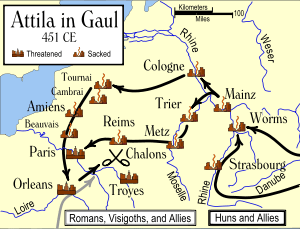
Valentinian was furious with his sister. Only the influence of the siblings’ mother Galla Placidia convinced the emperor to exile his sister rather than have her put to death. Meanwhile, frantic letters were scribbled off and dispatched to King Attila, explaining that it was all just a misunderstanding.
The king of the Huns wasn’t buying it. He sent an emissary to Ravenna, to claim what was his. Attila demanded delivery of his “bride” along with half the empire, as dowry.
In 451, Attila gathered his vassals and began a march to the west. The Hunnic force was estimated to be half a million strong, though that number is probably exaggerated. The Romans hurriedly gathered an army in opposition, while the Huns sacked the cities of Mainz, Worms and Strasbourg. Trier and Metz fell in quick succession, followed by Cologne, Cambrai, and Orleans.
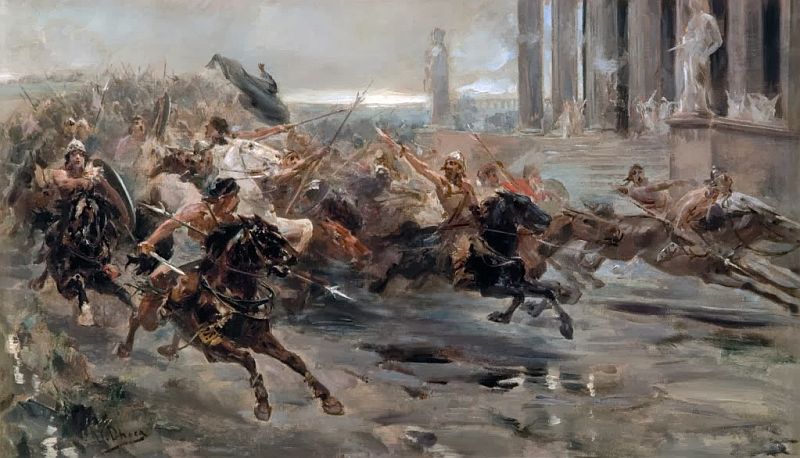
The Roman army, allied with the Visigothic King Theodoric I, finally stopped Attila’s army at the Battle of the Catalaunian Plains, near Chalons. Some sources date the Battle of Chalons to June 20, 451, others, September 20. Even the outcome of the battle is open to interpretation. Sources may be found to support the conclusion that it was a Roman, a Gothic or a Hunnic victory, as you choose.
Appearing to be a Pyrrhic victory, Chalons was one of the last major military operations of the Roman Empire, in the west. The Roman alliance had stopped the Hunnic invasion in Gaul but the military capacity of Roman and Visigoth both, was destroyed.
The Hunnic Empire itself was dismantled by a coalition of Germanic vassals at the Battle of Nedau, in 454.
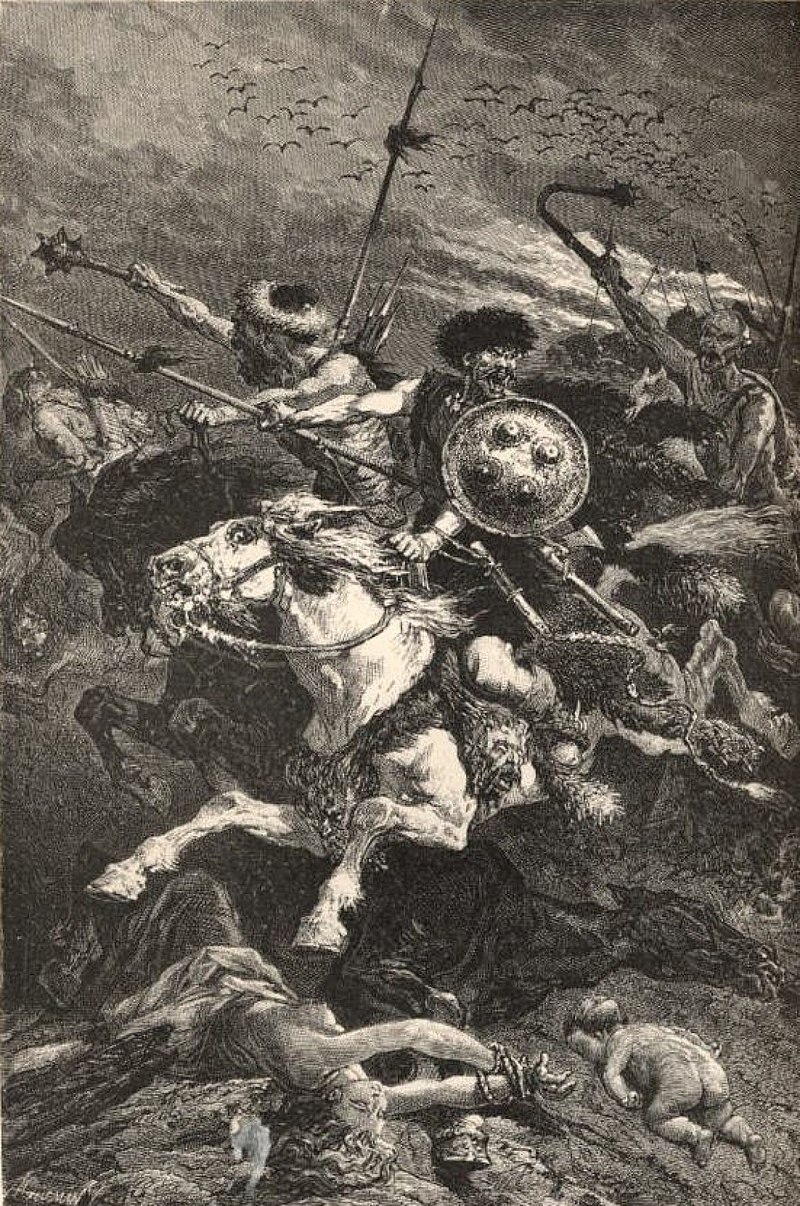
Attila would return to sack much of Italy in 452, this time razing Aquileia so completely that no trace was left behind. Legend has it that Venice was founded at this time when local residents fled the Huns, taking refuge in the marshes and islands of the Venetian Lagoon.
Attila died the following year at a wedding feast celebrating his marriage to the beautiful young Ostrogoth, Ildico. The King of the Huns died in a drunken stupor from a massive nosebleed, or possibly esophageal bleeding.
The eastern Roman and Greek historian Priscus wrote: “Shortly before he died, he took in marriage a very beautiful girl named Ildico, after countless other wives, as was the custom of his race. He had given himself up to excessive joy at his wedding, and as he lay on his back, heavy with wine and sleep, a rush of superfluous blood, which would ordinarily have flowed from his nose, streamed in deadly course down his throat and killed him, since it was hindered in the usual passages. Thus did drunkenness put a disgraceful end to a king renowned in war. On the following day, when a great part of the morning was spent, the royal attendants suspected some ill and, after a great uproar, broke in the doors. There they found the death of Attila accomplished by an effusion of blood, without any wound, and the girl with downcast face weeping beneath her veil“.
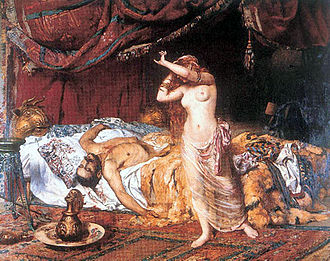
The Hunnic Empire died along with Attila the Hun as he choked to death, on his own blood.


